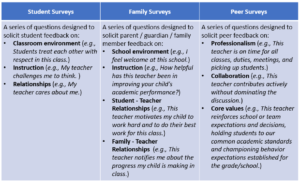Posts Tagged ‘professional development’
The Power of Cohorts
In today’s complex educational landscape, leadership can feel isolating. Whether you’re a Chief Academic Officer driving instructional excellence, a Superintendent exploring AI implementation, or a CTE leader shaping career pathways, the challenges you face are unique to your role—and often, you’re the only person in your organization navigating them.
At Hendy Avenue Consulting, we’ve witnessed firsthand how cohort learning transforms educational leadership. Our experience has shown that the most powerful professional growth happens when leaders come together in structured, purposeful communities.
Why Cohort Learning Works
The power of cohort learning lies in its fundamental truth: leaders need other leaders. When we bring together diverse talent in similar roles, something remarkable happens. Challenges that seemed insurmountable become opportunities for collective problem-solving. Individual expertise becomes shared wisdom. And perhaps most importantly, professional isolation transforms into lasting community. From adaptive leadership skill-building to tactical strategic planning to navigating change within an organization or across the broader educational sector, our cohorts aim to create space for thoughtful engagement and planning for leaders. We currently facilitate four distinctive cohort experiences, each designed to address specific leadership needs in education:
Chief Academic Officer Cohort: For CAOs in high-performing charter networks, this cohort creates a space where academic leaders can sharpen their vision and deepen their impact. Members engage in data-driven discussions, share remediation strategies, and collaborate on achieving equitable outcomes for all students.
AI Explorers Cohort: In partnership with AI for Equity, this nationwide community of practice supports senior executives as they navigate the AI revolution in education. Participants collaborate on everything from organizational planning to product evaluation, ensuring thoughtful and equitable AI implementation in their systems.
Career & Technical Education Group: Tailored for New York state CTE leaders, this program combines strategic planning with practical leadership development. Whether you’re a principal, assistant principal, or district director, you’ll find a community dedicated to advancing career and technical education.
District Educator Effectiveness Leader Cohort: Created for senior talent leaders in large public school districts, this cohort addresses the unique challenges of managing educator effectiveness initiatives at scale. Members find crucial thought partnership among peers who understand the complexities of their role.
The Hendy Approach to Cohort Learning
What makes our cohorts different? We believe effective cohort learning combines:
- Structured learning with organic relationship-building and thought partnership
- Immediate problem-solving with long-term strategic thinking
- Individual growth with collective wisdom
- Theory with practical application
Join Our Community
Educational leadership doesn’t have to be a solitary journey. Whether you’re looking to enhance your leadership, tackle complex challenges, or find a community of fellow leaders, our cohorts offer a proven path forward.
Interested in learning more? Explore our Cohorts page and discover how collaborative learning can transform your leadership journey.
Defining and Developing Teaching Excellence: The Hendy Instructional Excellence Rubric
Over the past 12 years, Hendy Avenue Consulting has partnered with numerous school systems to set a vision for excellent teaching, create and pilot instructional rubrics based on this vision, and implement those rubrics to support high-quality teacher coaching and development. These partnerships led to the creation of the Hendy Instructional Excellence Rubric, now freely available under a Creative Commons license on Hendy’s website. Five school systems across the country have already adopted some version of the Hendy Instructional Excellence Rubric. While Hendy tailors each engagement to the specific needs of the school system, Hendy’s close partnership with a large, multi-region charter school network served as the initial catalyst for what is now the Hendy Instructional Excellence Rubric.
The Challenge: The charter school network faced a significant challenge: their four regions were using different rubrics to define and develop excellent teaching. This inconsistency created disparities in how teachers were coached and supported across the network and missed opportunities to use the data to inform network priorities. The network reached out to Hendy to help them lead a project to create, pilot, and implement a unified vision of teaching excellence, aligning teacher development across all regions while maintaining high academic and instructional standards.
Setting the Foundation for Success: Hendy began with careful attention to organizational dynamics and stakeholder buy-in. The charter school network and Hendy established a clear RAPID decision-making framework and identified key stakeholders across departments whose participation would be crucial. This preliminary phase proved essential, establishing both the authority and the limitations within which the team would operate. This also ensured that the rubric development would center on what is most critical for students in classrooms: high-quality teaching and learning.
Creating a Common Vision of Excellence: Hendy convened a diverse subcommittee to lead the project, representing various roles (including talent, curriculum and instruction, and data), schools, tenure levels, and demographic backgrounds. This diverse representation ensured the rubric would be a practical tool for coaching and development. The subcommittee met regularly, engaging in deep discussions about what constitutes excellent teaching facilitated by Hendy team members. The group took a methodical approach to creating the new rubric. They began by discussing what excellent teaching looked like in different contexts and establishing a “blue sky” vision for teacher development. These conversations revealed both the strengths of existing approaches and the opportunities that a unified vision could provide. They conducted a detailed crosswalk of existing frameworks provided by Hendy, identifying the key elements that drove teacher growth across all contexts. This analysis helped the committee work with Hendy to create a rubric that would be both comprehensive and practical for everyday use. The team iterated on the rubric several times, testing different domains and indicators across different classrooms and contexts.
Piloting and Refining the Vision: The pilot phase demonstrated the charter school network’s commitment to thoughtful implementation. Hendy launched the pilot with an orientation webinar, introducing the rubric to the broader community and outlining its purpose, structure, and role in teacher development. This helped build understanding and buy-in. The webinar provided practical guidance for leaders to begin using the rubric while allowing for refinement based on their experiences. Recognizing the unique needs of certain teaching populations, Hendy and the charter team specifically engaged Special Education teachers, fine arts instructors, PE teachers, and preK educators through targeted surveys and focus groups. This ensured their perspectives would shape the final framework. Pilot schools used the rubric in multiple contexts. Leadership teams conducted walkthroughs using the new framework at least 2-3 times that spring, testing its effectiveness in different classroom settings. School leaders also used the framework in coaching conversations with teachers, providing valuable insights. Throughout the pilot, Hendy maintained a strong feedback loop, gathering input through structured surveys and focus groups and used this information to make adjustments. Critically, Hendy and the committee closed the feedback loop by communicating changes back to participants, explicitly connecting their input to specific modifications. Leaders found the rubric helpful in structuring coaching conversations, providing a common language for discussing teaching excellence. They also identified areas where additional guidance was needed, particularly around using the rubric to support different types of teachers and content areas.
Implementation, Training, and Capacity Building: The summer marked the transition to full implementation. In partnership with Hendy, the large, multi-region charter school network invested heavily in developing the capacity of those who would use the rubric. The implementation began with establishing clear systems and structures. Hendy worked with school leaders to determine coaching roles, the frequency of observations and coaching conversations, and how teachers would engage with the rubric. The subsequent training program facilitated by Hendy was comprehensive and sustained, extending through the summer and following school year. It began with foundation training, where coaches learned not just about the rubric’s structure but also how to use it as a tool for development. These interactive sessions included practicing with instructional video analysis and guiding coaching conversations. Quarterly practice-based sessions facilitated by Hendy throughout the school year reinforced learning. Each session followed a thoughtful progression: leaders would study specific indicators, analyze teaching videos, engage in calibration discussions, and practice coaching conversations. The embedded certification process was particularly effective. Rather than a one-time event, it was a supportive process allowing for multiple attempts and providing additional support when needed.
Legacy and Evolution: The Hendy Instructional Excellence Rubric: Hendy’s work on creating and implementing this charter school network’s rubric significantly influenced the development of the Hendy Instructional Excellence Rubric. The Hendy rubric builds upon the successful elements of the charter school network’s process while introducing innovations. Like its predecessor, the Hendy Instructional Excellence Rubric organizes teaching excellence into four domains, each guided by an essential question. It adds “Core Teacher Skills” for each indicator, providing specific, actionable guidance for teacher development. This helps bridge the gap between identifying excellent teaching and developing teachers’ practice. The Hendy rubric also refines the approach to measuring impact, maintaining the charter school network’s focus on student outcomes while creating clearer developmental progressions. This helps teachers and coaches identify specific next steps for growth.
Want to learn more about the Hendy Instructional Excellence framework? Visit our website or email Jessica Wilson!
Three Lessons for Meaningful Performance Management Incentives
We’re big fans of performance management. We know that for people to achieve their best, they need clear definitions of excellence, resources and tools to achieve that benchmark, and frequent, action-oriented feedback that drives their development. Too often, however, organizations don’t know how to link performance management efforts with valuable incentives for their talent.
Before we dig in, let’s get one thing out of the way: incentives in the workplace are not inherently good or bad. Done well, incentives can be a powerful tool for motivation, recognition and reward. Done poorly, incentives can lead people to feel controlled or set up for failure.
Incentives come in all shapes and sizes but most fit within one of the five Rs:
- Rewards: salary, incentives, bonuses, benefits
- Responsibilities: variety, autonomy, challenge, promotions, learning
- Relationships: coworkers, supervisors, clients, and customers
- Reputations: image, respect, appreciation, feedback
- Rest & Relation: hours, scheduling, flexible, travel, location
So what now? Maybe you want to give a bonus to high-performers, grant newcomers more autonomy or show appreciation to employees who routinely go above and beyond. In any situation, here are three recommendations to help you build a foundation for offering incentives:
- Set achievable, meaningful, and controllable benchmarks for employees. Ambitious goals are great but they should not be impossible to reach. Similarly, desired outcomes must matter to the person and organization. If mission driven, make clear the connection between the individual’s impact and how it helps the the organization get closer to their vision. It may seem obvious, but people also have to know that what they will be measured against can be reached by the levers within their control. We would never evaluate a bank teller by the number of light bulbs that need to be changed monthly, so test your goals to ensure a direct line back to employee actions and responsibilities.
- Know what people want. A huge problem is that organizations generally don’t know what their people want. For example, leaders may assume everyone is motivated by the same things or rely too heavily on what has historically been motivating. Particularly in large or longstanding organizations, there is too much application of the golden rule (treat others as you want to be treated) by decision-makers and not enough of the platinum rule (treat others as they want to be treated). There’s no secret to fixing this problem; you need to do your research (e.g., ask employees, read research on generational shifts, talk to industry leaders) and pilot before full-scale launch. The best approaches customize incentives for specific groups or individuals.
- Keep support and growth at the center. Earning an incentive should not be the end of the journey for your employees. Milestones are important, but should always be coupled with a “what’s next?” conversation so that people feel you are genuinely invested in their growth and development (which we hope you are!) and can tangibly see the road ahead. If one does not yet exist, take the opportunity to co-create. A common pitfall is focusing too much on monetary or extrinsic rewards, sometimes to the detriment of strong intrinsic motivators. Focusing on continual improvement and long-term development will help mitigate this risk.
How have you effectively implemented incentives? What’s been the most interesting outcome? Sound off in the comments below!
Three Steps to Avoid Common Observation Biases
We all have biases. Whether picking an ice cream flavor or choosing to take the scenic route rather than the highway, we all operate with mental models that place disproportionate weight on certain factors that move our judgment in favor of one option when compared to another.
When observing and evaluating teacher practice, there are numerous opportunities for biases to creep in. Just think of all the factors that go into a lesson: the subject, grade, school, teacher, time of day, lesson structure, materials used and more. An observer may think to themselves, “the students were well-behaved for the first class right after lunch”. A different person observing that same lesson may think, “if I was teaching this class, I would have used a different text.” Both of these sentiments may be true, but they have to be placed aside before conducting a visit so that observers can focus on objective teacher and student actions.
In short, great observers, coaches, and evaluators must identify, then set aside, biases in order to fairly and accurately evaluate and develop teacher practice.
Common biases include:
- Confirmation bias: the tendency to search for or interpret information in a way that confirms one’s preconceptions,
- Halo effect: the tendency for a person’s positive or negative traits to “spill over” from one area of their personality to another in others’ perceptions of them, and
- Mirror bias: the tendency to judge performance as “good” if it is “like I would have done it.
A full table of common observer biases with examples can be found here: Observer Bias Examples
In order to mitigate the impact of these biases, great observers should ask themselves three questions:

Round 3: Looking Back, Looking Ahead
In our previous two posts (here and here), Sarah and Grant shared reflections on the past year and projects they are looking forward to in the coming months. To bring us home, Jessica shares lessons learned on working through complexity and opportunities to lead with appreciation.
What I learned: I have spent most of my career in education supporting and working in large bureaucracies, namely large urban districts and state education agencies. Just prior to joining Hendy Avenue I was in senior leadership in one of the largest school districts in Ohio. Each of the organizations I’ve worked with in the past have faced challenges, and I tended to chalk those up to organizational complexity, and the difficulty that comes with arriving at solutions when you must invest a large number of people and perspectives in the strategies. After spending my first year with Hendy working with diverse organizations and districts, I came to appreciate that the challenges I faced in past contexts are not so different from those faced by clients of all sizes. I’ve learned that it’s often not only the scale and bureaucracy that causes the challenges we face in K-12 education, and that we can learn a lot from organizations of different sizes and types in finding solutions. As we partner with our clients this year, we are excited to continue to bring lessons learned from all shapes and sizes of districts, states, schools and networks to arrive at solutions to problems.
What I’m excited about: I am so happy to get to continue to partner with Independence Mission Schools in Philadelphia. Having attended Catholic schools as a child, I have a great appreciation and admiration for the work IMS is doing for some of Philadelphia’s most deserving students. We learned a lot from IMS’ leaders and teachers as we supported them last fall to implement their new instructional framework, and to modify that framework to fit their Catholic culture. Now, I’m excited to continue to support IMS leaders as they deeply invest in teachers through teacher leadership. This project has been a welcome opportunity to explore how others are solving a problem, learn more about the context, strengths and opportunities in IMS schools, and devise a program that makes a difference for teachers, and students, across the network.
Round 2: Looking Back, Looking Ahead
In our last post, Looking Back, Looking Ahead: Lessons Learned and What’s to Come in 2018-19, our founder Sarah shared insights on the difficulty of leading change and the excitement around re-engaging with one of our first partners.
This week, we hear from Grant:
What I learned: Historian and philosopher Will Durant said, “we are what we repeatedly do. Excellence, then, is not an act, but a habit.” Durant’s much-quoted line rings true in most endeavors, especially in efforts to drive change. Over the past year, we’ve seen the power of habitual communication–to teachers, school leaders, regional administrators–in sharing consistent messages, building shared understanding and demonstrating competence. Nothing derails stakeholder buy-in more than mixed messages or a lack of information! Habitual communication requires consistent content, format, and tone through a single channel at a regular, expected frequency. In Houston, we’ve supported KIPP in the development of a weekly message to School Leaders around implementation of Teacher Pathways. Each Friday, leaders know they will receive updates, shout outs, resources, and reminders to guide the week ahead. In Delaware, we’ve launched a monthly newsletter for district leaders on DPAS_II, the state’s teacher evaluation system, with a consistent agenda including deadlines and professional development opportunities. These habitual communications do more than provide information, they demonstrate competence and care for colleagues and trust between stakeholders. As you think about the programs you’re leading, consider how you can habitualize communication as a repeatedly do.
What I’m excited about: In 2014, KIPP Texas – Austin began a comprehensive effort to reshape teacher effectiveness and retention through the development of a Teacher Career Pathway. Knowing that great teachers drive student achievement, Austin’s Teacher Career Pathway develops, recognizes and rewards excellent educators so they will get better and stay longer. This fall, the first cohort of Distinguished Teachers will be announced; a group of accomplished educators who have demonstrated consistent gap-closing results for kids, impeccable teaching practice and exemplary professional contributions to the school community. We cannot wait to celebrate these remarkable educators!
Looking Back, Looking Ahead: Lessons learned and what’s to come in 2018-2019
As consultants, our role is to guide our partners to make informed decisions and to successfully meet their goals. We also prioritize building the knowledge and skills of our partners and they tell us that they learn a lot from working alongside us. In turn, we learn so much every day from the incredibly smart and diverse partners we have the good fortune to work with!
As we reflect on the past and look ahead to the new school year, we are grateful for all that we have learned from our clients. In our next couple of blog posts, each Hendy team member will share something he or she has learned and something we’re excited about it. It’s going to be a great year!
To kick us off, read below from our founder, Sarah Rosskamm:
What I learned: Change is hard. Often times the solution is to prepare for change, engage stakeholders, continuously communicate the “why”, work with influencers, plan for challenges and ultimately to just keep going even when it gets tough. There are times, however, when the solution is to pause, reflect and change course. In working with one of our partner charter networks this year, we learned that sometimes the most courageous and best answer is to stop doing something. In this case, our partner was eager to build a teacher career pathway. They took many important steps to get there, had buy-in from leaders and momentum from teachers believing it was valuable. However, they also had budget changes, shifts in capacity and new demands of their attention. As a result, they smartly decided to pause. They stopped putting their attention into the pathway and instead narrowed the scope of their focus to implementing a highly effective evaluation and development structure that would help their teachers to grow and enable them to target their professional learning activities. They focused on laying a foundation that would immediately benefit teachers through continued growth, and will ultimately allow them to move more quickly toward a pathway if and when they choose to pick it up again. It wasn’t easy (for the network or for the Hendy team) to not complete our original shared goal, but it was the right thing to do for their teachers and students.
What I’m excited about: Hendy Avenue’s very first consulting project was supporting the Delaware Department of Education as they considered revisions to their teacher evaluation rubric. After considering several rubric options based on the best of the available rubrics at the time, the Delaware team, similar to the team described above, decided to pause and learn more before making changes to a statewide tool. So, we shifted course and supported four charter schools in Wilmington to design and implement an alternative evaluation system for their teachers that would utilize this new rubric. I worked closely with the leaders in those schools for several years and together we instituted an alternative system that is now used in a growing number of Delaware schools through their Alternative Evaluation system. I am so excited that five years later, after learning a great deal about the use of the current rubric and about the alternative system, Delaware leadership is eagerly partnering with teachers, leaders and other stakeholders to revise the rubric to ensure the tool is well-aligned to new standards and meets the needs of teachers across the state. I’m also thrilled the state has very wisely decided to prioritize involvement of teachers and leaders in the process and to take the time necessary to ensure it’s a positive and welcomed change for their well deserving teachers. And I’m even more excited that Hendy Avenue will be partners in engaging stakeholders, designing, piloting, revising and ultimately building a rubric that helps teachers and leaders be the very best they can be for their students.
Put Excellence at the Heart of Performance Management
Performance management, at its core, sets expectations. It puts a stake in the ground for what “good” looks and sounds like in the classroom and serves as the baseline of teacher observation rubrics. Effective performance management is more than diagnosing current performance; it supports teachers to articulate an actionable, clear trajectory toward excellence. Ultimately, a vision of good teaching and learning must be at the heart of any performance management system.
Common Pitfall: Framework Without Vision
Too often schools and districts launch a performance management system by creating or selecting a rubric without consideration of core instructional priorities. Enthusiasm and urgency, while helpful, can lead to less than ideal system design.
For example, simply adopting an existing framework because it is “proven” or “research-based” might not actually lead schools and teachers to excellence: what might be excellent teaching in one context might not be true in another setting. Creating a framework from scratch in a vacuum, separate from instructional priorities, isn’t likely to lead teachers to excellence either.
This doesn’t mean that adopting an existing framework is the wrong strategy, or that creating something new won’t get leaders and teachers where they need to be. It does mean, though, that this work must be grounded in the core realities of instruction necessary to move kids.
Ground Performance Management in a Vision for Excellent Instruction
Co-design and co-own by instructional leaders. Defining excellence for as complex a role as teaching requires a team of individuals, with different areas of expertise and focus. While very often, the development of teacher evaluation systems lives within talent/human resources, great systems strategically draw in additional stakeholders. For quality operations, a talent leader should drive and own the design and implementation of a performance management framework. At the same time, this work should be a shared priority between leaders of talent, academics and school management functions in a network or district. Instructional leaders working in schools daily must be the core authors and implementers of expectations for teachers.
Measure what matters. If teachers are held to expectations through a framework that aligns with core instructional priorities, schools are more likely to see improvement in the areas that matter most for students. If a solid instructional vision grounds all decision making, then curricular resources, training, and other supports will naturally stem from that vision. As teachers are supported to meet expectations via appropriate the resources, materials, and training, student learning will flourish.
Lead from your vision. Consider the following questions, and strategically engage others to ensure answers reflect the perspectives of a broad range of stakeholders:
- What are our prevailing beliefs within our system about students, and the role teachers play in their success?
- What do the instructional standards require from our students? And then, by extension, from our teachers?
- In classrooms where good teaching and learning is happening, what are teachers doing? What are students doing?
- How does this differ for different students? Different contexts?
- How do we ensure that the performance management system we design reflects our vision of excellent teaching?
- Who will own this work? How will we ensure that leaders from talent and instruction both continue to be involved?
Let us know what you think in the comments below!
-Jessica
Thank You Teachers!
As we look forward to celebrating Thanksgiving with our families this week, the Hendy Avenue team is reflecting on the many blessings for which we are thankful. We are thankful for our family and friends. We are thankful for the opportunity to partner with wonderful organizations doing incredible work for children. We are thankful for clients who have become friends. We are thankful to work with our fabulous Hendy team members who make us think harder and laugh more.
We are also thankful for the many people in our lives who have helped us along the way. Today we give thanks for the teachers who have shaped our lives and highlight just a few of them.
Sarah: My favorite teacher was Mrs. Ayers, my elementary art teacher. She had an energy and passion for her subject that was contagious and I fell hard for creating art. She brought a talent out of me and made me feel truly special. I think the best teachers are able to connect with their students and bring out a curiosity and a confidence that translates to other parts of their lives. Thank you, Mrs. Ayers!
Jess: My favorite teacher was Mr. Hoffman, my high school English teacher. I was a math and science geek in high school, and never really valued literature. I thought that spending all of my time in the analytical world of experiments and functions would get me to my goals. Mr. Hoffman helped me to understand and appreciate the value of balance in academics and in life. We read the great novels in a way that helped me to build my critical thinking skills in a different way. Thank you, Mr. Hoffman!
Grant: I have to give a Thanksgiving shout out to my AP US History teacher, Mr. Corcoran. The one word that comes to mind when I think back to Mr. C’s class is rigor. Not only was the course demanding in terms of workload, but it was a intellectually exhausting and exhilarating experience, every day. You had to show up prepared, engage with your peers, argue your points, and justify your thinking. Nothing less than our best was accepted. Thank you Mr. Corcoran for pushing me to demand excellence of myself and forging how to think, write, and speak with integrity.
Designing Evaluation Frameworks with Development at the Core – Part III: Amplifying Stakeholder Voice with Surveys
This post is the third in a series on how innovators are reimagining the design and implementation of evaluation and development frameworks. Read our earlier posts on observation frequency and raising rubric rigor.
When you think of a teacher, where are they? What are they doing? If you envisioned someone standing in front of a blackboard, lecturing a group of students, you’re likely not alone. In reality however, teachers spend their days in a multitude of ways: working individually with students, collaborating with peers, planning independently, connecting with parents and family members.
Definitions of excellent teaching therefore must go beyond classroom observations and measures of student outcomes (both of which are important!), to gather a broader view of a teacher’s impact.
Surveys are a simple, yet powerful tool that can amplify the voices of stakeholders from across a school community to help educators develop a comprehensive view of excellence.
The Benefits of Administering Surveys
- Surveys, coupled with other measures like classroom observations, provide rich information to help teachers improve their practice. Teaching is a complex job that depends on strong relationships. While districts and schools have made progress in collecting data and providing feedback on certain aspects of the profession (e.g., content knowledge, teaching strategies, assessment data), our field often misses the opportunity to coach teachers on their relationship building with students, families and peers.
- Research says that students are reliable evaluators of a teacher’s impact. Analysis by the Measures of Effective Teaching (MET) project finds that teachers’ student survey results are predictive of student achievement gains. In other words, students know an effective classroom when they experience one.
- Surveys provide the opportunity to put values into practice. Value statements like “we are a team and family” or “parents are partners” are powerful; however, these beliefs are only as true as the actions taken to build an authentic community. Administering surveys of key stakeholders sends a strong message that the voices of community members are valued, respected and heard.
- Surveys provide clear and transparent expectations to teachers. When questions are shared with teachers in advance, the survey content provides clear definitions for expected behaviors in teacher-to-teacher, teacher-to-student, and teacher-to-family relationships. For example, if a survey asks families if they receive one or more positive phone calls a month from their child’s teacher, that sets a very clear expectations for the teacher-family relationship.
Survey Types
Educators have available a number of survey types, structures, question formats and administration platforms.The table below highlights three common survey types.
Surveys should be designed thoughtfully, taking into consideration the purpose, audience, and respondents.
- Purpose – Why are you administering the survey? What do you hope to learn? How will results be utilized?
- Audience – Who will analyze and interpret the survey results? When and how will they reflect on and plan from the results? How will the results be debriefed with teachers to improve practice?
- Respondents – Who will complete the survey? When and how will they complete the survey? What directions, supports and technology will be necessary for administration?

To learn more, including a list of sample survey questions, visit the resources page of our website.










